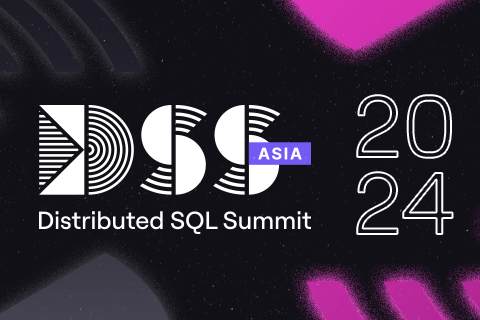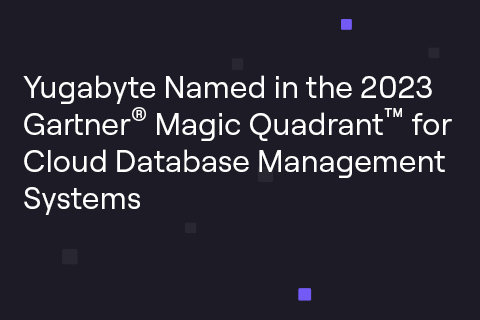How-to: The Northwind PostgreSQL Sample Database Running on a Distributed SQL Database
The Northwind database is a sample database that was originally created by Microsoft and used for various database product tutorials for decades. The Northwind database contains the sales data for a fictitious company called “Northwind Traders,” which imports and exports specialty foods from around the world. The Northwind database is an excellent tutorial schema for a small-business ERP, with customers, orders, inventory, purchasing, suppliers, shipping, employees, and single-entry accounting. The Northwind database has since been ported to a variety of non-Microsoft databases including PostgreSQL.
In this post we are going to walk you through how to download and install the PostgreSQL-compatible version of Northwind on the YugabyteDB distributed SQL database.
What’s YugabyteDB? It’s a high performance distributed SQL database for global, internet-scale apps. YugabyteDB is a PostgreSQL-compatible database. Similar to Google Spanner, YugabyteDB gives you all the scalability characteristics of NoSQL, without sacrificing the ACID transactions or strong consistency you are accustomed to with PostgreSQL.
Download and Install YugabyteDB
For complete instructions on how to get up and running on a variety of platforms including prerequisites, check out our Quickstart Guide. In the following section we’ll cover the basic steps for getting up and running in just a few minutes with a local 3 node cluster on your Mac.
Download and Extract YugabyteDB
$ wget https://downloads.yugabyte.com/yugabyte-2.0.1.0-darwin.tar.gz
$ tar xvfz yugabyte-2.0.1.0-darwin.tar.gz && cd yugabyte-2.0.1.0/
Note: The above instructions are for version 1.3.0. To find the latest version of YugabyteDB, visit the quickstart page.
Configure Loopback Addresses
Add a few loopback IP addresses for the various YugabyteDB nodes to use.
sudo ifconfig lo0 alias 127.0.0.2
sudo ifconfig lo0 alias 127.0.0.3
sudo ifconfig lo0 alias 127.0.0.4
sudo ifconfig lo0 alias 127.0.0.5
sudo ifconfig lo0 alias 127.0.0.6
sudo ifconfig lo0 alias 127.0.0.7
Create a 3 Node Cluster
With the command below you’ll create a 3 node cluster with a replication factor of 3.
$ ./bin/yb-ctl --rf 3 create

Check the Status of the YugabyteDB Cluster
Now let’s take a look at the status of the cluster and all the nodes that comprise it.
$ ./bin/yb-ctl status
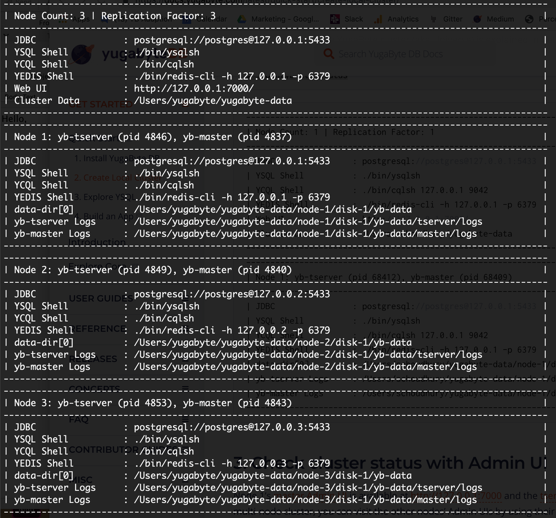
As you can see from the output, we have three nodes running locally with a replication factor of 3. This means that every piece of data is being replicated on all three nodes.
Enter the YSQL shell
Next run the ysqlsh command to enter the PostgreSQL shell.
$ ./bin/ysqlsh --echo-queries
ysqlsh (11.2)
Type "help" for help.
postgres=#
What’s YSQL? It’s YugabyteDB’s PostgreSQL-compatible, distributed SQL API.
We are now ready to build the Northwind database.
Download and Install the Northwind Sample Database
Download Northwind
You can download the Northwind database that is compatible with YugabyteDB from our GitHub repo. Here’s the two files you’ll need:
- northwind_ddl.sql which creates tables and other database objects
- northwind_data.sql which loads the sample data into Northwind
Create the Northwind Database
CREATE DATABASE northwind;
Let’s confirm we have the Northwind database by listing out the databases on our cluster.
postgres=# \l

Switch to the Northwind database.
postgres=# \c northwind
You are now connected to database "northwind" as user "postgres".
northwind=#
Build the Northwind Tables and Objects
northwind=# \i /Users/yugabyte/northwind_ddl.sql
We can verify that all 14 of our tables have been created by executing:
northwind=# \d
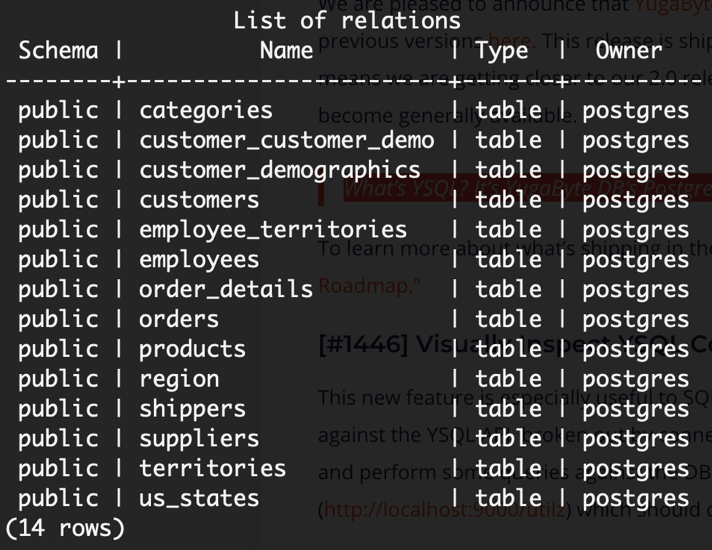
Load Sample Data into Northwind
Next, let’s load our database with sample data.
northwind=# \i /Users/yugabyte/northwind_data.sql
Let’s do a simple SELECT to pull data from the customers table to verify we now have some data to play with.
northwind=# SELECT * FROM customers LIMIT 2;
Explore Northwind
The dataset consists of 14 tables and the table relationships are showcased in the entity relationship diagram below:
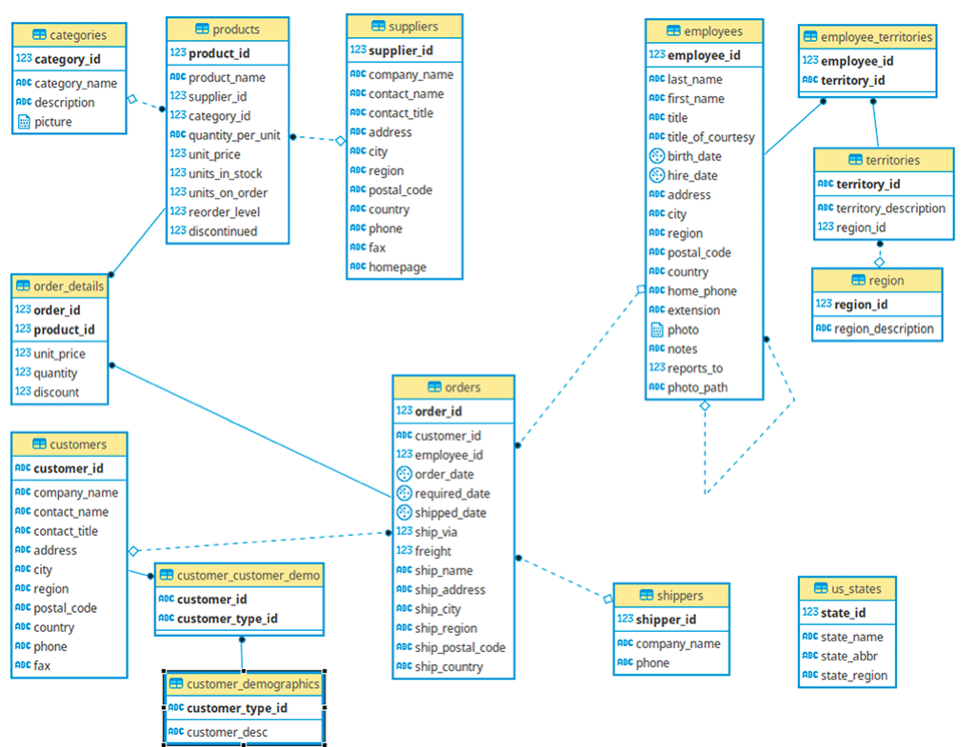
The dataset contains the following:
- Suppliers: Suppliers and vendors of Northwind
- Customers: Customers who buy products from Northwind
- Employees: Employee details of Northwind traders
- Products: Product information
- Shippers: The details of the shippers who ship the products from the traders to the end-customers
- Orders and Order_Details: Sales Order transactions taking place between the customers & the company
That’s it! Using the command line or your favorite PostgreSQL development or administration tool, you are now ready to start exploring the Northwind database and YugabyteDB features.
What’s Next
- Compare YugabyteDB in depth to databases like CockroachDB, Google Cloud Spanner and MongoDB.
- Get started with YugabyteDB on macOS, Linux, Docker, and Kubernetes.
- Contact us to learn more about licensing, pricing or to schedule a technical overview.

